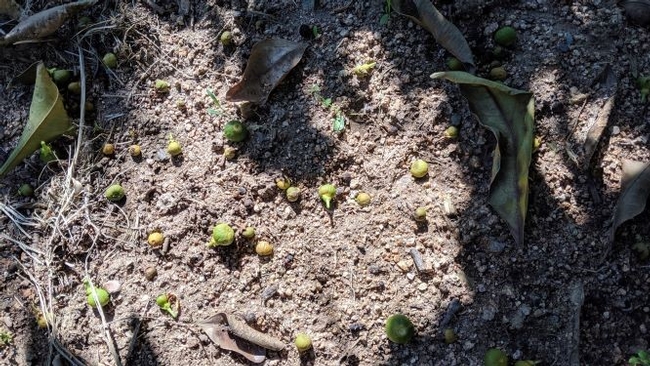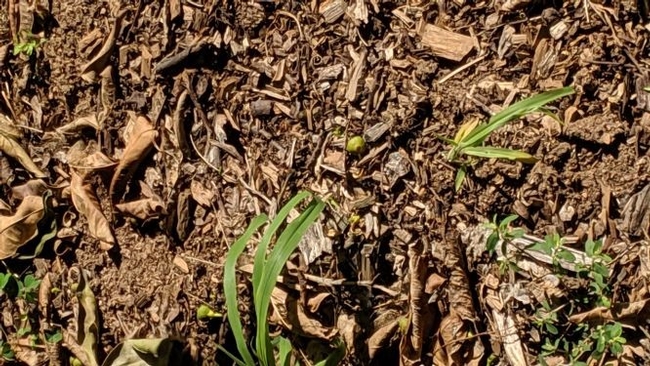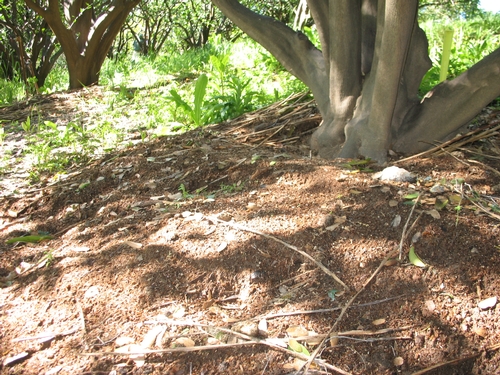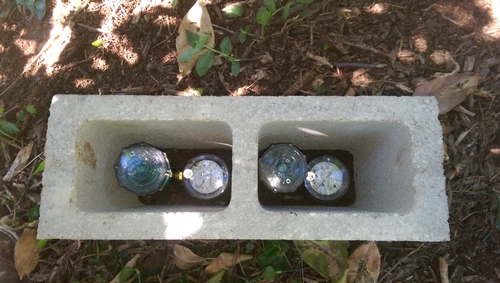
Posts Tagged: mulch
Observations on Mandarin Mulching Research
Two years ago, UCCE Placer/Nevada embarked on a study to evaluate pruning and mulching in five local mandarin orchards. In a blog posted in June 2017, I discussed the beginnings of the study, the specific treatments and what the study was hoping to accomplish in the coming years. As the study enters the third year and data analysis begins, there are some observations that we should share.
The environment in our orchards is changing. We are experiencing unpredictable temperature swings and extreme periods of rainfall. Soil moisture levels this past winter and spring reached saturation levels for a prolonged period.
Roots need both water and oxygen. In saturated soils, oxygen in the soil pore spaces is displaced by water. This year, tree stress increased as the roots struggled to breathe. When root cells can't get oxygen, they die. Without them, the rest of the tree starts to die too. Many of us suffered tree loss due to the suffocation of root systems.
As orchards and fields began to dry, temperatures began to swing from high to low in unpredictable patterns. Stress was further introduced into the system. In the past few weeks, recorded temperatures in the five orchards have gone from lows in the 40's to recorded highs of 105 in the first few weeks of June. Citrus has a tendency to drop fruit that the tree cannot support and increased tree stress can increase fruit drop.
Field observations over the past few weeks show that drop is occurring at a much higher rate and volume in treatments that haven't been mulched. The picture on the left is from underneath the canopy of a tree without mulch (Control) and to the right is a mulched tree. These two trees are in the same orchard, approximately 18 feet apart.
Soil moisture levels are being monitored under both of these trees. Moisture levels under the mulched tree are consistent with what one would expect. The soil profile is able to retain moisture with minimal depletion at a 6-12” depth. Most moisture depletion is occurring in the top 6” of soil and is minimal compared to the Control. Moisture levels in the Control deplete at a more rapid rate throughout the soil to a depth of 12”. Once again, tree stress is on the rise. The soil moisture in the Control profile becomes much harder to replenish, resulting in longer irrigation cycles.
Soil temperature at a depth of 9” is also being monitored. Data from the Control show rather significant increases and decreases in temperatures in short periods of time. Data from the mulched tree reflect more temperature stability with the highs lower than those in the Control soil. Again, it seems that the Control may be under more stress due to the rapid temperature swings that the root mass is encountering.
It would certainly seem that a cursory examination of the data with field observations shows that mulching is a beneficial production practice in an orchard. However, there are some considerations to be had before one just charges ahead with this practice.
First, as we learned, timing is everything. Mulch should only be applied when the moisture in the soil profile is at capacity. Experience has taught us that applying the mulch when soil moisture is low results in playing catch up. I have observed orchards that were never able to replenish the full soil moisture content during the irrigation season.
Second, monitoring soil moisture is important. Mulching will change your irrigation timing and frequency. In our study, the period between irrigation cycles in mulched orchards has increased. Maturation appeared to be slowed in orchards that chose to stay with their old programs and not effectively monitor the soil moisture. Mulch reduces moisture loss from the soil, so if irrigation was not adjusted, the soil under the mulch stayed too wet. While less dramatic than the saturated soil situation this spring, stress was induced by the tree roots struggling to obtain oxygen and maturation slowed.
Certainly, mulching requires a little more effort on the grower's part. But is the not the reduction or control of the stress induced in the growing system beneficial to the entire orchard system? As a grower, I know that adding a little bit of stress into my trees at the right time and conditions is good for the fruit. Adding that stress at a time when it will not damage the tree or cause crop loss is key. Mulching certainly seems to mitigate stress in the growing system when stress is detrimental to the crop and system. Further data analysis will also provide us with more insight into the benefits that the mulch provides to the soil biology and composition. We will share those insights as they become available.
Build the soil for successful gardening
Before digging in to spring planting, pay attention to building the soil, advises an article in the Los Angeles Times by Jeanette Marantos.
Marantos visited the Pasadena backyard garden of Yvonne Savio, the retired coordinator of the UC Master Gardener Program in Los Angeles County. Savio is the creator of the Gardening in LA blog, with new stories appearing "every other week or so."
“The old saying is, ‘Feed the soil, not the plant,'" Savio said. “When you just use chemical fertilizers, you're not establishing a long-lasting base of nutrition for the plant. It's just giving it a huge piece of cake on Sunday, and then by Thursday it's nutritionally starving.”
Savio recommends a steady diet of organic matter be spaded into soil, and a layer of organic mulch added to the top of soil.
When you continually add organic amendments to the soil, the dirt comes alive as the amendments decompose, creating the beneficial bacteria, fungi and the nutrients plants need to grow strong and healthy, Savio said. “It's really like a cafeteria where your plants can pick and choose what they really like.”
Citrus Research in the Foothills: What we have learned so far
Growing mandarins in the foothills often produces a tantalizing crop of fruit that delights even the pickiest of connoisseurs, however, it is not produced without difficulty. UCCE Placer/Nevada has collaborated with five local citrus growers to research the effects of pruning to thin canopy and mulching to conserve soil moisture and create a healthier root zone. To learn more about this project, read Citrus Grower Bob Bonk's blog post, Mandarin Growers Test New Practices on the Foothill Farming blog. Research began just over a year ago and here are some of the things we have learned so far.
Mulching:
Mulch under citrus trees helps maintain soil moisture, reduces soil temperatures, and can effectively manage weed growth.
Methods: Mulch is best applied when the soil is saturated. Typically mulch is applied in March/April in this region but can be applied later if soil is irrigated to saturation level. Mulching is most effective for weed suppression when either little to no weed emergence has occurred, weed whacking, or herbicide spray is implemented first. Mulch alone reduces weed growth. Mulch applied over builder's paper or 6-8 sheets of newspaper then saturated to conform to the ground is even more effective. Fertilizer is best applied before mulching.
Materials: A 50/50 wood chip and horse manure blend is used in the research trials but either one can be used on its own. Composted manure alone decomposes rapidly, a mix of manure with wood chips will last longer. Wood chips last longer than either the wood chip/manure mix or manure alone but will provide little to no nutrient value to the tree.
Irrigation:
We have observed that often irrigation with overhead sprinklers does not penetrate dense tree canopies and may lead to water stress. Tensiometers, which measure soil moisture, were installed in citrus orchards in summer 2017. They showed that overhead irrigation water was not reaching the ground under dense canopies, causing water stress in hot weather. As a result of some of this research, several commercial citrus growers have modified irrigation practices or are changing irrigation systems to mitigate water stress.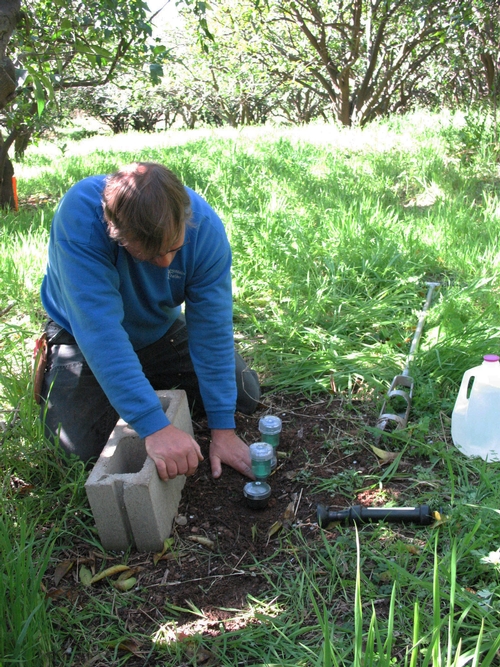
Looking to the future:
Soil temperature can affect root activity so beginning this year soil temperature are also being monitored throughout the research project. Citrus growers are attending workshops, field meetings, and learning what the orchard trials are teaching us. Many are implementing new methods and practices in their citrus operations. Citrus trials will continue at least through 2019. Look for more information in future blogs.
Commercial growers are invited to participate in a Composting & Mulching Workshop on Thursday, May 31st, 9 AM to 12 noon, register at this link. http://ucanr.edu/survey/survey.cfm?surveynumber=24853
Mulch the soil surface to save water in home landscapes

Gable recommends the soil in home landscapes be covered with two to four inches of a fine- to medium-shred bark mulch. The mulch should not be applied too close to the bases of the plants so they won't be susceptible to rot.
UC Master Gardeners in Sonoma County have provided detailed information about various types of mulch, their benefits and drawbacks. For example, straw is a common, effective and inexpensive mulch. Alfalfa hay or pellets are more expensive, but because they are rich in nitrogen, give plants a nutrient boost.
Barks and hulls make an attractive, natural-looking surface. These products are often available at hardware and garden stores in bags, and in bulk at landscaping material suppliers.
Another cost-effective mulch is yard waste. Fallen leaves, grass clippings and chopped plant clippings of any kind can be spread on the soil surface to enhance and protect the soil, while reducing water evaporation.
View the video here:
View the previous videos in the UC ANR home landscape water conservation series:
Early-morning watering is best
Remove weeds from your landscape
The videos are also available on the UC ANR YouTube channel.
Coming next week, a video about using fertilizers under drought conditions.
An initiative to improve California water quality, quantity and security is part of the UC Division of Agriculture and Natural Resources Strategic Vision 2025.
Author: Jeannette Warnert
Degradation of potentially biodegradable plastic mulch films at three diverse U.?S.? locations
From WeedsNews4791 | February 22, 2014 | 11:30 pmPosted by Zheljana Peric Abstract: For widespread adoption of biodegradable plastics as agricultural mulches, dependable biodegradation across contrasting conditions is necessary.? The in situ degradation of four potentially biodegradable...

